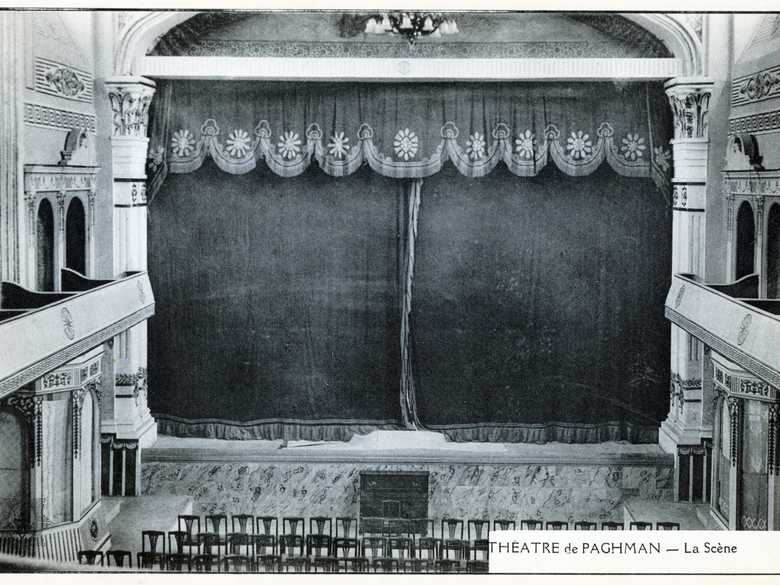SdA 3-116 — L’intérieur du théâtre
L’intérieur du théâtre, avec une vue sur la scène dans la partie nord-ouest du bâtiment. Devant la scène, dans le fossé un piano. Des deux côtés de la scène, deux énormes piliers rectangulaires finissant dans un chapiteau corinthien. Le mur de la scène est peint en style trompe-l’œil, imitant le marbre. Le rideau est tiré. La salle peut être illuminée grâce au chandelier visible en haut au centre. Le mur du parterre, structuré par des arcades aveugles, est décoré d’une sorte de grille en style t...
L’intérieur du théâtre, avec une vue sur la scène dans la partie nord-ouest du bâtiment. Devant la scène, dans le fossé un piano. Des deux côtés de la scène, deux énormes piliers rectangulaires finissant dans un chapiteau corinthien. Le mur de la scène est peint en style trompe-l’œil, imitant le marbre. Le rideau est tiré. La salle peut être illuminée grâce au chandelier visible en haut au centre. Le mur du parterre, structuré par des arcades aveugles, est décoré d’une sorte de grille en style trompe-l’œil et légèrement bombé, comme le balcon. Les deux dernières portes de chaque partie latérale du balcon sont surmontées d’un fronton circulaire contenant des bustes.
THÉATRE de PAGHMAN — La Scène
- Souvenir d'Afghanistan, séries 1 et 2 : n’y figure pas.
- Parr, D.J. (1975) : Architecture in Afghanistan, 1880-1929, pp. 159-161 et Fig. 226-230 : description du théâtre, construit en 1925-1926, p. 159 : «The large theatre or cinema for it was equipped with a projector and screen, was located [northwest of the mosque]. Several films were shown in the theatre and the Parliament of 1928, which convened upon Amanullah’s return from his European tour, met in this structure. […] During the 1920’s, the cinema was a relatively new invention, and this structure was the first structure to be built in Afghanistan for the showing of films. […]» ; p. 161 : «The interior was elaborately decorated. Four Corinthian style engaged pilasters, two on each side, supported the large four centred arch located in front of the stage. Molded plaster forms decorated the spandrels above this arch, as well as many other sections of the interior. Stencilled designs were also used to decorate the interior surface. The cinema was burned during the uprising of 1929, for the films it showed were considered irreligious. […]»
- Dupree, N.H. (1977) : An Historical Guide to Afghanistan, p. 128-130 : description de la situation de Paghman des années 1970.
- Adamec, L.W. (1985) : Kabul and Southeastern Afghanistan, p. 614 : Paghman.
- Schinasi, M. (1990) : Italie-Afghanistan 1921-1941, II. De l’affaire Piperno à l’évacuation de 1929. Le journal de De Gado, p. 282 : «Pour le théâtre […] la chose est claire. Le bâtiment était « quasi finito » pour la semaine des fêtes […] rappelant chaque année l’avènement d’Amanullah et la dite indépendance. […] De Gado, qui avait mené à bien le projet de son prédécesseur – non sans peine, rapporte-t-il, car celui-ci avait refusé de lui communiquer ses plans -, fut félicité par l’émir. […]»
Image No.
SdA 3-116
Collection
Souvenir d’Afghanistan 1925-1927
Series
SdA 3/4 (double face, 1927) 113 à 152 : Paghman, Bâtiments 2
Format
image : 134/200 mmplanche : 148/218 mmcouverture bleue ou verte
Quality
excellente ; noir et blanc
Place, date
Paghman, après 1924
Descriptors
Latitude / Longitude34.596588 / 68.949731
Google Earth34°35’48'' N / 68°56’59'' E / 2360 m
Google Mapshttps://maps.google.com
Zoom Earthhttps://zoom.earth
You know more about this picture?


